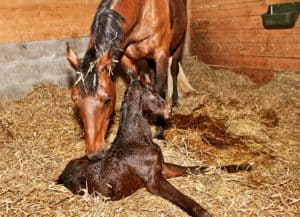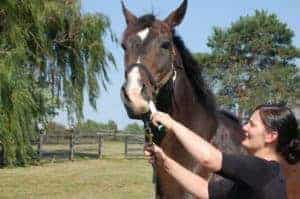Improving Equine Fertility

7 practical tips to optimize equine conception rates
Bringing a foal into the world is no small feat. Few events in a breeder’s life are as exciting as seeing a heartbeat on the ultrasound screen, and few are as frustrating as finding an empty womb. Subfertility can be a complex, multifaceted issue affecting the mare, stallion, or both. For conception to occur, many conditions—from adequate hormonal production and a healthy uterus to sufficient amounts of progressively motile sperm cells—must unite at precisely the right time. To shed light on the fertility troubles many breeders encounter, two theriogenologists have shared seven practical tips centered around getting a mare in foal.
1. Start with a healthy horse.
A fertile horse is, first and foremost, a healthy horse. Before even considering reproductive abilities, horse owners must determine whether the animal is fit to procreate and, in the case of the mare, carry a 340-day, 150-pound pregnancy to term. Charlie Scoggin, DVM, MS, Dipl. ACT, a shareholder at Rood & Riddle Equine Hospital in Lexington, Kentucky,,encourages owners to maximize the efficiency and longevity of their horses’ breeding careers by being proactive about overall health. His recommendations for preventive care are rooted in sound horse-keeping practices:
- Keep horses current on core and risk-based vaccinations, deworming, and dentistry.
- Screen for metabolic diseases as recommended by your veterinarian.
- Evaluate dietary needs periodically. Ejaculation and gestation, respectively, draw on the stallion’s and broodmare’s body resources, so be sure to meet their nutrient requirements. A deficiency or imbalance could negatively impair fertility rates of either sex. In stallions, researchers have found that selective supplementation of the omega-3 docosahexaenoic acid (DHA) can improve both sperm quality and quantity.
Scoggin adds that pain or inflammation stemming from anywhere in the body can negatively impact reproductive success. “Addressing any coexisting health issues in an effort to eliminate pain will pay dividends in maintaining and preserving a horse’s fertility,” he says.
2. Cover the mare, but also the basics.
Often, what we deem infertility is the result of a mare not being bred with sufficient amounts of quality semen at the correct time during her estrous cycle. For conception to occur, a healthy spermatozoon must meet a healthy oocyte at just the right time—and our job is to optimize the conditions for this union to take place.
“To achieve maximum fertility rates, a mare must be inseminated with at least 500 million progressively motile sperm cells 24 to 48 hours prior to ovulation,” says Alana King, DVM, Dipl. ACT, a theriogenologist at Millbrook Equine Veterinary Clinic, in New York. So, if your mare isn’t “catching” after a few cycles, check that you’ve covered the basics before turning to invasive and expensive fertility treatments. Ensure you have:
- A healthy mare with a healthy uterus.
- An adequate semen dose for insemination.
- Healthy semen, meaning at least 50% of the sperm are morphologically normal and progressively motile.
- Inseminated the mare within a narrow window of time before ovulation.
3. Begin the breeding season with a breeding soundness exam.
Much like the prepurchase exam on a performance horse, the breeding soundness exam (BSE) serves to gauge a mare’s ability to carry out her job as a broodmare and identify or predict any special care she might need. Both King and Scoggin agree that for mares, a BSE includes at the very least a rectal palpation and ultrasonography (of the uterus, cervix, and ovaries), vaginal examination, and uterine culture and cytology. These steps allow your veterinarian to:
- Check the integrity of the protective seals of the mare’s reproductive tract—the vulvar lips, vestibulovaginal fold, and cervix. These barriers protect the uterus from contaminants. If compromised, they could put a pregnant mare at risk of placentitis (placental inflammation) and even abortion.
- Note the presence and determine the nature of any intrauterine fluid or large cysts. Fluid accumulation is often associated with endometritis (inflammation/infection of the uterine lining) and negatively affects a mare’s ability to conceive and carry a foal—an embryo cannot affix to an unhealthy uterine lining and further develop.
- Determine if the mare is cycling normally (evident when examining ovaries and their follicles).
If the mare has a history of subfertility, both King and Scoggin recommend further diagnostics in the form of hysteroscopy (running a flexible endoscope into the uterus to check for abnormalities), uterine biopsy, and endocrine and/or genetic screening, depending on the case.
On the stallion side, the most reliable measure of fertility is generally his overall pregnancy rate. Sometimes veterinarians perform BSEs on stallions, as well—often as part of a prepurchase exam or to investigate suspected subfertility. In addition to a physical and rectal exam, an integral part of the stallion BSE is the collection and analysis of an ejaculate sample. This can provide valuable information about semen volume, concentration, motility, and morphology, all of which can influence pregnancy rates.
4. Address reproductive issues before the first insemination.
Just as an injured sport horse shouldn’t step into the show ring, a mare with a compromised uterus shouldn’t go to the breeding shed. Inseminating a mare while she’s battling endometritis or dealing with large cysts is a waste of time, semen, and money. If her perineal conformation is less than ideal, a Caslick’s procedure (suturing the vulva) might be needed to avoid further uterine contamination with debris and harmful pathogens, Scoggin says.
As for cysts, those 2.5-3 centimeters or larger and located at the base of a uterine horn can interfere with embryo fixation and survival, King says. “Small cysts are generally left alone, but very large or numerous ones need to be removed before the mare is bred,” she says.
5. Evaluate the pros and cons of using frozen semen.
Semen is available in fresh, chilled, or frozen forms. Introduced in the 1960s, cryopreservation (freezing) of semen was a game-changing advancement that allows us to breed mares to stallions worldwide and even long-deceased, using artificial insemination (AI). In theory, freezing semen provides infinite sperm cell longevity as long as the straws are stored, handled, and thawed correctly. But the reality is these extra processes lead to lower pregnancy rates than those achieved with fresh and chilled (cooled) semen. Researchers have attributed this to several factors, including removal of the seminal plasma, cell membrane damage, and insufficient sperm doses.
“Fertility is assessed as a stallion’s per-cycle pregnancy rate, or the percentage of mares bred that become pregnant for each (estrous) cycle,” King says. “Whether the semen is fresh, chilled, or frozen, an average stallion will have a pregnancy rate of around 65-75%, with less than 60% considered subfertile. Pregnancy rates are typically slightly lower for chilled semen and lower still for frozen, though they ideally should still remain in the 60% range.”
6. Consider assisted reproductive techniques if needed.
Vets pursue assisted reproductive techniques (ART) for many reasons, with scarcity of high-quality stallion semen at the top of the list. The techniques include:
- Deep-horn insemination With this method the practitioner manually deposits the semen deep into one uterine horn, close to the site of fertilization (typically the sperm reaches the egg in the oviduct, on its way from the ovary to the uterine horn tip). “This procedure can be very useful in cases where a limited amount of semen is available, such as with valuable frozen semen, sex-sorted semen (processed to ensure arrival of the desired sex—colt or filly), or semen from certain cases of subfertility in the stallion,” says King. Deep-horn insemination can achieve satisfactory pregnancy rates with 100 times fewer sperm than the amount typically used in traditional AI.
- Reinforcement breeding This approach involves collecting the stallion’s dismounting ejaculate sample and manually depositing it into the uterus after live cover to maximize sperm numbers entering the mare’s reproductive tract. It has been found to increase pregnancy rates by up to 11.7% (Blanchard, 2006).
- Intracytoplasmic sperm injection (ICSI) This in-vitro procedure consists of injecting a single sperm cell directly into the oocyte, then placing the resulting embryo either back into the donor mare (auto-transfer) or into a recipient mare (embryo transfer). “The main advantage is ICSI requires only a small amount of semen, an appealing trait when sperm count is low,” says Scoggin.
- Ovulatory agents Human chorionic gonadotropin (hCG) and deslorelin acetate (SucroMate) are two drugs that help veterinarians align the timing of ovulation with that of insemination, maximizing the chances of conception.
With any ART, make sure the breed registry permits its use, says Scoggin, who works extensively with Thoroughbreds—for which live cover is the only permissible form of breeding if the offspring is destined for racing. While The Jockey Club prohibits AI and all related practices, it does allow reinforcement breeding and the use of ovulatory drugs.
7. Address persistent mating-induced endometritis promptly.
Nine out of 10 mares experience mild, transient inflammation of the uterus post-breeding that resolves on its own and does not affect conception rates. “However, there is that one mare who experiences persistent mating-induced endometritis (PMIE) and proves difficult to get in foal,” says Scoggin. “This is often an older (>14 years) multiparous (has had several foals) mare with a history of accumulating—and failing to clear—fluid within her uterus. If the fluid isn’t cleared by the fifth day post-ovulation, when the embryo descends from the oviduct into the uterus, the pregnancy is at risk. Therefore, quelling any persistent inflammatory response without delay is essential. In PMIE cases, treatment consists of uterine lavage as early as six hours post-breeding, oxytocin injections to promote uterine clearance, and, in some cases, steroids or non-steroidal anti-inflammatory drugs (NSAIDs).”
Because bacterial endometritis often follows PMIE, veterinarians might also administer antibiotics, King says. To reduce the likelihood of PMIE, she recommends against breeding susceptible mares with frozen semen. “The freezing process results in a larger proportion of dead spermatozoa,” she explains. “When combined with the lack of seminal plasma previously described, these dead sperm cells cause many mares to have intensive post-breeding reactions at insemination.”
Take-Home Message
It’s simple in theory: One spermatozoon meets one oocyte, and your new foal is on the way. In practice, several key factors must align—timing, semen quality, and uterine health—to establish pregnancy. As a horse owner and breeder, creating a plan to optimize your horse’s health and fertility is the best investment you can make in the future of your equine offspring.

Written by:
Lucile Vigouroux
Related Articles
Stay on top of the most recent Horse Health news with












